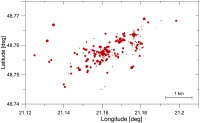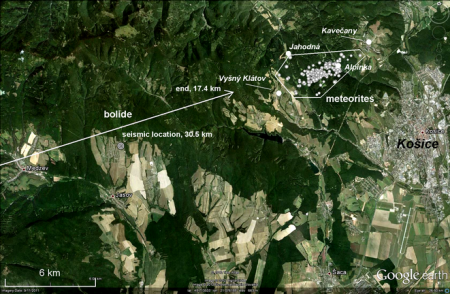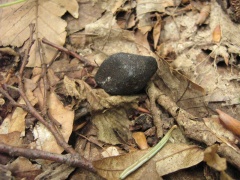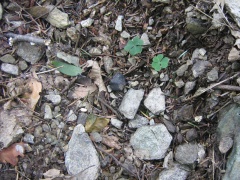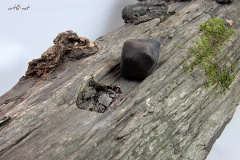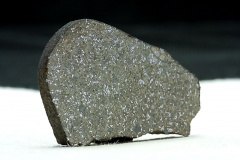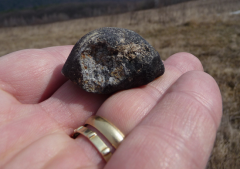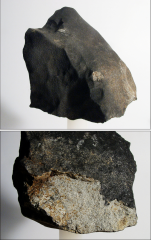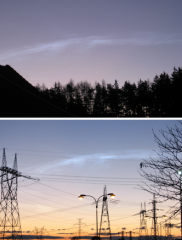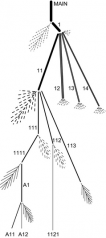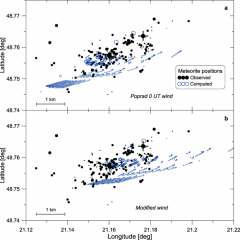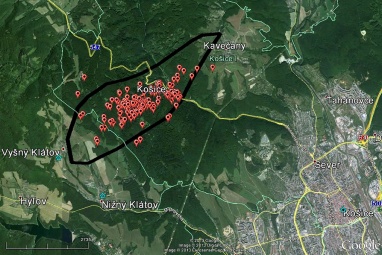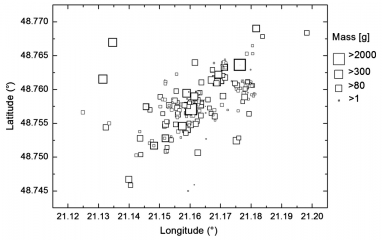(Unless otherwise stated, the copyright of the materials included belong to Jan Woreczko & Wadi.)
Košice
Z Wiki.Meteoritica.pl
m (→Bibliografia) |
m (→Galerie) |
||
| Linia 95: | Linia 95: | ||
Okazy meteorytu Košice ''in situ'' i ich budowa wewnętrzna | Okazy meteorytu Košice ''in situ'' i ich budowa wewnętrzna | ||
| - | <gallery caption="" widths=" | + | <gallery caption="" widths="240px" heights="180px" perrow="3"> |
File:Kosice_(7_g_in_situ).jpg|Kompletny okaz o wadze 7,39 g ''in situ'', znaleziony 8 sierpnia 2010 roku <br>(N48°45.736', E21°09.337') | File:Kosice_(7_g_in_situ).jpg|Kompletny okaz o wadze 7,39 g ''in situ'', znaleziony 8 sierpnia 2010 roku <br>(N48°45.736', E21°09.337') | ||
File:Kosice_(8_g_in_situ).jpg|Ośmiogramowy okaz w miejscu znalezienia | File:Kosice_(8_g_in_situ).jpg|Ośmiogramowy okaz w miejscu znalezienia | ||
| Linia 104: | Linia 104: | ||
Przebieg zjawiska, model, znaleziska (źródło: {{!doi|10.1111/maps.12078|text=Borovička et al. 2013}}) | Przebieg zjawiska, model, znaleziska (źródło: {{!doi|10.1111/maps.12078|text=Borovička et al. 2013}}) | ||
| - | <gallery caption="" widths=" | + | <gallery caption="" widths="240px" heights="240px" perrow="3"> |
File:Kosice_(Borovicka_MaPS_2013)-fig08.png|''The first Košice meteorite (27 g) found close to the village of Vyšný Klátov by Juraj Tóth on March 20, 2010'' | File:Kosice_(Borovicka_MaPS_2013)-fig08.png|''The first Košice meteorite (27 g) found close to the village of Vyšný Klátov by Juraj Tóth on March 20, 2010'' | ||
File:Kosice_(Borovicka_MaPS_2013)-fig09.png|''Two views of the second largest Košice meteorite (2.17 kg)<ref name="main mass"></ref> found close to the Alpínka settlement by Tereza Krejčová on March 25, 2010'' | File:Kosice_(Borovicka_MaPS_2013)-fig09.png|''Two views of the second largest Košice meteorite (2.17 kg)<ref name="main mass"></ref> found close to the Alpínka settlement by Tereza Krejčová on March 25, 2010'' | ||
| Linia 114: | Linia 114: | ||
Mapy rozkładów znalezionych okazów (źródło: {{!doi|10.1111/maps.12447|text=Tóth et al. 2015}}) | Mapy rozkładów znalezionych okazów (źródło: {{!doi|10.1111/maps.12447|text=Tóth et al. 2015}}) | ||
| - | <gallery caption="" widths=" | + | <gallery caption="" widths="382px" heights="260px" perrow="2"> |
File:Kosice_(Toth_MaPS_2015)-fig02.jpg|'''''Fig. 2.''' Recovered 218 Košice meteorite fragments (red dots) between villages Vyšný Klátov and Kavečany (about 5 km west of the city Košice) within the predicted strewn field area by J. Borovička (black line) by March 11, 2010. The first meteorite was found at the southwest side of the strewn field by March 20, 2010. The size of the strewn field is 5 × 3 km. The densest part of 90% recovered meteorites occupied area of 2.6 × 1.2 km. The whole strewn area consisted of low ridges and valleys with the altitudes ranging from 300 to 600 m above sea level, but some slopes are steep. The strewn field is covered mostly by woods, meadows are less present. The main road from Košice to Margecany crosses the northeast part of the strewn field, where the recreational area Alpinka is located (one of the main fragments was recovered there).'' | File:Kosice_(Toth_MaPS_2015)-fig02.jpg|'''''Fig. 2.''' Recovered 218 Košice meteorite fragments (red dots) between villages Vyšný Klátov and Kavečany (about 5 km west of the city Košice) within the predicted strewn field area by J. Borovička (black line) by March 11, 2010. The first meteorite was found at the southwest side of the strewn field by March 20, 2010. The size of the strewn field is 5 × 3 km. The densest part of 90% recovered meteorites occupied area of 2.6 × 1.2 km. The whole strewn area consisted of low ridges and valleys with the altitudes ranging from 300 to 600 m above sea level, but some slopes are steep. The strewn field is covered mostly by woods, meadows are less present. The main road from Košice to Margecany crosses the northeast part of the strewn field, where the recreational area Alpinka is located (one of the main fragments was recovered there).'' | ||
File:Kosice_(Toth_MaPS_2015)-fig04.png|'''''Fig. 4.''' The distribution of recovered fragments (218 pieces) in the strewn field (geographical longitude and latitude) versus their mass. The overall size of the strewn field for fragments smaller than 10 g is smaller by selection effect. The majority of fragments heavier than 100 g follow the line from southwest to northeast (except two fragments on the west, and one fragment on the east).'' | File:Kosice_(Toth_MaPS_2015)-fig04.png|'''''Fig. 4.''' The distribution of recovered fragments (218 pieces) in the strewn field (geographical longitude and latitude) versus their mass. The overall size of the strewn field for fragments smaller than 10 g is smaller by selection effect. The majority of fragments heavier than 100 g follow the line from southwest to northeast (except two fragments on the west, and one fragment on the east).'' | ||
| Linia 120: | Linia 120: | ||
| - | {| | + | :{| |
|- | |- | ||
| - | |<youtube>gijln8XzbVU</youtube> | + | |<youtube height="240">gijln8XzbVU</youtube> |
| - | + | [http://youtu.be/gijln8XzbVU Meteor over Hungary – The Best Video] | |
| - | |<youtube>mvJkhiUUAT8</youtube> | + | |<youtube height="240">mvJkhiUUAT8</youtube> |
| - | + | [http://youtu.be/mvJkhiUUAT8 Meteor Örkényről (Fazzi Daniella – www.idokep.hu)] | |
|- | |- | ||
|YouTube – [http://youtu.be/tPPDjLYMh1M Meteor Strike over Hungary 02/28/ 2010] | |YouTube – [http://youtu.be/tPPDjLYMh1M Meteor Strike over Hungary 02/28/ 2010] | ||
Wersja z 21:56, 11 gru 2024
Duży wkład poszukiwaczy amatorów
| Košice → | |
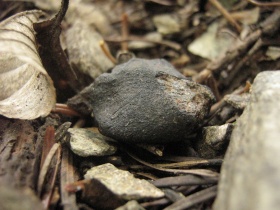
Kilkugramowy okaz meteorytu Košice
| |
| Spadek | |
| Lokalizacja | Vyšný Klátov, niedaleko Koszyc, Słowacja |
| Położenie[1] | 48°45'49"N, 21°10'35"E |
| Data | 28 lutego 2010 r., 22:24:46 UT (niedziela) |
| Uwagi | deszcz meteorytów |
| Charakterystyka | |
| Typ | chondryt zwyczajny H5 |
| Masa | 4,3 kg[2] |
| Liczba okazów | kilkadziesiąt okazów (78 szt.), największy 2,19 kg[2][3] |
| Cechy | S3, W0 |
| Meteoritical Bulletin Database | |
| Synonimy → | |
| Kosice, Koszyce | |
Spadek deszczu meteorytów w Słowacji 28 lutego 2010 roku (niedziela).
28 lutego 2010 roku około godziny 22:24:46 czasu UT niebo nad Europą Środkową rozświetlił bardzo jasny bolid. Ze względu na złą pogodę zjawiska tego nie zarejestrowały stacje sieci Fireball Network Central European (prowadzone przez Pavela Spurnýego z Czeskiej Akademii Nauk), również w Słowacji Video Network (obsługiwane przez Juraja Tótha z Uniwersytetu Comenius w Bratysławie) nie działały tej nocy. Więc w pierwszej chwili wydawało się, że nie ma zapisów tego wydarzenia. Okazało się jednak, że kilka czujników fotometrycznych na stacjach paliw zarejestrowało pojaśnienia. Również kilku obserwatorom na Węgrzech udało się zarejestrować na video przelot bolidu. Na podstawie tych danych udało się określić moment i czas trwania zjawiska, analizy wykonał Jiří Borovička. Bolid osiągnął jasność –18m oraz zarejestrowano jeden silny rozbłysk. Udało się również wyznaczyć potencjalne miejsce spadku fragmentów bolidu. Dane ze stacji sejsmicznych potwierdzały spadek.
Znaleziono zapisy fal dźwiękowych z sześciu stacji sejsmicznych i czterech infradźwiękowych. Po dokładnej kalibracji, zapisy wideo zostały wykorzystane do obliczenia trajektorii bolidu i jego prędkości. Meteoroid, o szacunkowej masie 3500 kg, wszedł w atmosferę z prędkością 15 km/s po torze o nachyleniu 60° do poziomu. Największy fragment przestał być widoczny na wysokości 17 km, gdzie wyhamował do prędkości 4,5 km/s. Maksymalna jasność absolutna około –18m została osiągnięta na wysokości 36 km. Opracowano szczegółowy model fragmentacji atmosferycznej, tak aby pasowały do obserwowanej krzywej zmian blasku i hamowania. Okazało się, że meteoroid Koszyce był słabo związaną bryłą, której fragmentacja rozpoczęła się przy ciśnieniu dynamicznym 0,1 MPa, a najsilniejsza fragmentacja zachodziła przy ciśnieniu poniżej 1 MPa. Siedem godzin po przelocie, rano przed wschodem słońca, obserwowano jeszcze unoszącą się chmurę pyłu (Borovička et al. 2013).
Fragmenty meteorytu spadły we wschodniej Słowacji na północny zachód od Koszyc w pobliżu miejscowości Vyšný Klátov. Jest to lekko górzysty teren porośnięty lasami z łąkami i polanami. W elipsie spadku znajduje się kompleks pól golfowych Alpinka.
Zorganizowano wyprawę poszukiwawczą, którą kierowali Pavel Spurný, Juraj Tóth i Jan Svoreň. Pierwsze dwa fragmenty meteorytu (oddalone od siebie ~100 m) znalazł 20 marca Juraj Tóth. W ciągu kilku kolejnych wypraw (w okresie od 20 marca 2010 roku do 28 października 2011 roku zorganizowano 8 ekspedycji w których brało udział kilkadziesiąt osób) znaleziono w sumie ponad 70 okazów. Najmniejszy miał 0,57 grama, największy 2,19 kg[3][4]. W sumie zebrano 78 okazów o wadze 4,33 kg (Tóth et al. 2014). Wiadomo również, że ekipy z innych krajów znalazły wiele okazów, nawet kilkuset gramowe. Według danych jakie udało się zebrać od innych poszukiwaczy, znaleziono łącznie 218 okazów o całkowitej wadze 11,3 kg (Tóth et al. 2014).
Meteoryt Košice to chondryt zwyczajny typu H5, stopniu zwietrzenia W0 i zszokowania S3. 27 czerwca 2011 roku został oficjalnie zarejestrowany w Meteoritical Bulletin Database.
Wyznaczono również parametry heliocentryczne asteroidy, z której spadł deszcz meteorytów Košice. Z danych wynika, że około 0,5-3 milionów lat temu w wyniku kolizji dwóch asteroid, oderwany fragment o średnicy około 1,25 m (~3,5 tony) wszedł na stabilną orbitę:
- wielka półoś a=2,71±0,24 AU,
- mimośród e=0,647±0,032,
- odległość: perihelium q=0,957±0,004 AU, aphelium Q=4,5±0,5 AU,
- nachylenie orbity i=2,0±0,8°,
by po około 100 tys. lat wejść 28 lutego 2010 roku w kolizję z Ziemią.
Lokalizacja
(K) Košice, (V) Vyšný Klátov
(A) Golfové ihrisko Alpinka
Trajektoria bolidu
* W 2018 roku Google zmieniło zasady działania apletu, mapa może wyświetlać się niepoprawnie (pomaga Ctrl+F5); więcej → Szablon:GEMap-MyWiki
Obszar spadku to łąki, polany i las. Teren jest trudny, górzysty.
miejsca znalezienia części okazów (czerwony punkt – miejsce znalezienia masy głównej)
Schematyczny obszar spadku (Borovička et al. 2013)
* W 2018 roku Google zmieniło zasady działania apletu, mapa może wyświetlać się niepoprawnie (pomaga Ctrl+F5); więcej → Szablon:GEMap-MyWiki
Jest bardzo prawdopodobne, że nie udało się zebrać wszystkich spadłych fragmentów. Nawet w rejonach przeszukanych przez zorganizowane grupy z Czech i Słowacji, udało się innym znaleźć nowe okazy. Według Tóth et al. (2014) zespołom z różnych krajów udało się zebrać łącznie 218 okazów o łącznej wadze 11,3 kg.
Na mapie zaznaczono część znalezisk poszukiwaczy z Polski. Największy okaz ma 318,0 g, najmniejszy 1,2 g.
Mapa rozkładu znalezisk (źródło: Borovička et al. 2013)
Oficjalne poszukiwania zaowocowały znalezieniem 78 okazów, dodatkowo 140 sztuk zostało znalezionych przez prywatnych poszukiwaczy. Zidentyfikowane miejsca znalezisk zajmują obszar ponad 5 km długi i 3 km szeroki. Teren to pagórki i doliny, niekiedy o stromych zboczach, średnia wysokość terenu 300-600 m n.p.m. Około 90% pokrywają głównie bukowe lasy.
Galerie
Okazy meteorytu Košice in situ i ich budowa wewnętrzna
Zdarzały się też takie cymesy (fot. Art&Met; więcej na EoM) |
||
Przebieg zjawiska, model, znaleziska (źródło: Borovička et al. 2013)
Two views of the second largest Košice meteorite (2.17 kg)[3] found close to the Alpínka settlement by Tereza Krejčová on March 25, 2010 |
The atmospheric dust cloud photographed on the morning of March 1 (7 h after the bolide). The upper photo was taken by Dušan Veverka in Brno, the lower photo was taken by Michael Kročil in Dukovany at 6:15 local time. Source: http://ukazy.astro.cz |
|
Schematic of the Košice fragmentation model. Individual fragments and groups of fragments are designed by their names (numbers). The widths of the lines are proportional to fragment masses. Eroding fragments and dust releases are drawn schematically. Dotted lines are used if only small particles were released; dashed lines mark presence of medium-sized fragments; solid lines are used if sizable fragments (≥0.1 kg) were produced as well |
Comparison of the positions of recovered meteorites with the modeled meteorite positions using the Poprad radiosonde wind (top) and manually modified wind profile (bottom). The wind profiles are shown in Fig. 19. The sizes of the symbols correspond to the meteorite masses (one symbol size per order of magnitude mass). The two largest meteorites are emphasized by crosses. The modeled meteorite sample contains only representative pieces, not all expected meteorites |
Mapy rozkładów znalezionych okazów (źródło: Tóth et al. 2015)
Fig. 2. Recovered 218 Košice meteorite fragments (red dots) between villages Vyšný Klátov and Kavečany (about 5 km west of the city Košice) within the predicted strewn field area by J. Borovička (black line) by March 11, 2010. The first meteorite was found at the southwest side of the strewn field by March 20, 2010. The size of the strewn field is 5 × 3 km. The densest part of 90% recovered meteorites occupied area of 2.6 × 1.2 km. The whole strewn area consisted of low ridges and valleys with the altitudes ranging from 300 to 600 m above sea level, but some slopes are steep. The strewn field is covered mostly by woods, meadows are less present. The main road from Košice to Margecany crosses the northeast part of the strewn field, where the recreational area Alpinka is located (one of the main fragments was recovered there). |
Fig. 4. The distribution of recovered fragments (218 pieces) in the strewn field (geographical longitude and latitude) versus their mass. The overall size of the strewn field for fragments smaller than 10 g is smaller by selection effect. The majority of fragments heavier than 100 g follow the line from southwest to northeast (except two fragments on the west, and one fragment on the east). |
YouTube – Meteor Strike over Hungary 02/28/ 2010 YouTube – Égi jelenség Magyarországon (Meteorit above Hungary)
Bibliografia
- Borovička Jiří, Tóth Juraj, Igaz Antal, Spurný Pavel, Kalenda Pavel, Haloda Jakub, Svoreň Ján, Kornoš Leonard, Silber Elizabeth, Brown Peter, Husárik Marek, (2013), The Košice meteorite fall: Atmospheric trajectory, fragmentation, and orbit, Meteoritics & Planetary Science, vol. 48(10), 2013, s. 1757–1779.[5] Plik doi; plik aDs.
- Borovička Jiří, Spurný Pavel, Brown Peter, (2015), Small Near-Earth Asteroids as a Source of Meteorites, arXiv.org, arXiv:1502.03307, 2015 (abstrakt).[6] Plik PDF; plik doi.
- Gritsevich Maria, Vinnikov Vladimir, Kohout Tomáš, Tóth Juraj, Peltoniemi Jouni, Turchak Leonid, Virtanen Jenni, (2014), A comprehensive study of distribution laws for the fragments of Košice meteorite, Meteoritics & Planetary Science, vol. 49(3), 2014, s. 328-345. Plik doi.
- Kohout Tomáš, Havrila Karol, Tóth Juraj, Husárik Marek, Gritsevich Maria, et al., (2014), Density, porosity and magnetic susceptibility of the Košice meteorite shower and homogeneity of its parent meteoroid, arXiv.org, arXiv:1404.1245, 2014.[7] Plik PDF.
- +Kubovics Imre, Turcsányi Anasztázia M., Vizi Pál Gabor, (2010), Trajectory and Speciality of Fireball-Meteorite “2010.02.28 Cassovia” from Security Cameras and from Reports of Local Inhabitants, AMRC Symposium 2010. Plik PDF.
- Kubovics Imre, Vizi Pál Gabor, Bendő Zsolt, (2012), Trajectory and Analysis of Fireball-Meteorite “2010.02.28 Kosice” from Security Cameras and from Electron Microscopic Examination, 43th Lunar and Planetary Science Conference, Texas, 2012. Abstract [#2816].
- Lipka Jozef, Sitek Jozef, Dekan Július, Degmová Jarmila, Porubčan Vladimír, (2013), Mössbauer study of Slovak meteorites, Hyperfine Interactions, 218, 2013, s. 107–111.[8] Plik doi.
- Ozdín Daniel, Plavčan Jozef, Horňáčková Michaela, Uher Pavel, Porubčan Vladimír, Veis Pavel, Rakovský Jozef, Tóth Juraj, Konečný Patrik, Svoreň Ján, (2015), Mineralogy, petrography, geochemistry, and classification of the Košice meteorite, Meteoritics & Planetary Science, vol. 50(5), 2015, s. 864–879. Plik doi; plik aDs.
- Povinec Pavel P., Tóth Juraj, (2015), The Fall of the Košice Meteorite, Meteoritics & Planetary Science, vol. 50(5), 2015, s. 851-852. Plik doi; plik aDs.
- Povinec Pavel P., Masarik Jozef, Sýkora Ivan, Kováčik Andrej, Beňo Juraj, Meier Matthias M.M., Wieler Rainer, Laubenstein Matthias, Porubčan Vladimir, (2015), Cosmogenic nuclides in the Košice meteorite: Experimental investigations and Monte Carlo simulations, Meteoritics & Planetary Science, vol. 50(5), 2015, s. 880-892. Plik doi; plik aDs.
- Sansom Eleanor Kate, (2016), Tracking Meteoroids in the Atmosphere: Fireball Trajectory Analysis, Ph.D. thesis (dysertacja), supervisor Philip Bland, Faculty of Science and Engineering, Curtin University, 2016.[10] Plik hPDF.
- +Sitek Jozef, Dekan Július, Sedlačková Katarína, (2016), Analysis of Košice Meteorite by Mössbauer Spectroscopy, Journal of Electrical Engineering, 67(4), 2016, s. 307-310. Plik doi.
- +Tóth Juraj, Svoreň Ján, Borovička Jiří, Spurný Pavel, Igaz Antal, Porubčan Vladimír, Kornoš Leonard, Husárik Marek, Krišandová Zuzana, Vereš Peter, Kaniansky S., (2010), Meteorite Košice – The Fall in Slovakia, International Meteor Conference, IMC 2010, Sep. 16-19, 2010, Armagh, UK. Plik PDF.
- Tóth Juraj, et al., (2011), The Košice Meteorite, International Meteor Conference, IMC 2011, Sep. 15-18, 2011, Sibiu, Romania.[11] Prezentacja PDF.
- Tóth Juraj, (2011), Planéty, asteroidy a meteority, wykład w ramach Bratislavská vedecká cukráreň, Bratislava 2011.[12] Plik PDF.
- Tóth Juraj, Borovička Jiří, Igaz Antal, Spurný Pavel, Kornoš Leonard, Haloda Jakub, Ozdín Daniel, Povinec Pavel P., Sýkora Ivan, Veis Peter, Kohout Tomáš, Svoreň Ján, Husárik Marek, Vereš Peter, Porubčan Vladimír, (2014), Meteorit Košice - nález a analýzy, Esemestník. Spravodajca Slovenskej mineralogickej spoločnosti, 1, 2014, s. 20-21. Plik PDF.
- Tóth Juraj, Svoreň Ján, Borovička Jiří, Spurný Pavel, Igaz Antal, Kornoš Leonard, Vereš Peter, Husárik Marek, Koza Július, Kučera Aleš, Zigo Pavel, Gajdoš Štefan, Világi Jozef, Čapek David, Krišandová Zuzana, Tomko Dušan, Šilha Jiří, Schunová Eva, Bodnárová Marcela, Búzová Diana, Krejčová Tereza, (2015), The Košice meteorite fall: Recovery and strewn field, Meteoritics & Planetary Science, vol. 50(5), 2015, s. 853–863.[5] Plik doi; plik aDs.
Przypisy
Zobacz również
- spadek meteorytu Morávka
Linki zewnętrzne
- Meteoritical Bulletin Database (MBD) – meteoryt Košice
- Encyclopedia of Meteorites (EoM) – meteoryt Košice
- Meteoryt Łowicz w kolekcjach polskich – Wadi & Jan Woreczko Collection
- Wikipedia – Elementy orbitalne
- woreczko.pl – Sieci bolidowe (Fireball network)
- Portal Meteorite Picture of the Day – Košice
- Astronomical and Geophysical Observatory in Modra – Meteorite “Kosice”, the fall in Slovakia
- TVNoviny.sk – Vo Vyšnom Klátove našli zvyšky meteoritu
- Korzár.sk – Astronómovia našli pri Vyšnom Klátove zvyšky meteoritu
- Krajská hvezdáreň a planetárium – Meteorit "Košice"
- Kysucká hvezdáreň – Mimoriadny úspech slovenských astronómov
- Hvězdárna a planetárium Plzeň – Nedaleko Košic nalezeny úlomky meteoritu ● Jasný záblesk nad Slovenskem
- Astronómiu a astrofotografia – Expedícia meteorit Košice – 6-8. apríl 2010
- Kereszty Zsolt (Magyar Meteoritikai Társaság) – A Košice (kassai) meteorit hullás, 2010
- Spadek meteorytu Košice na YouTube – meteorit hungary
